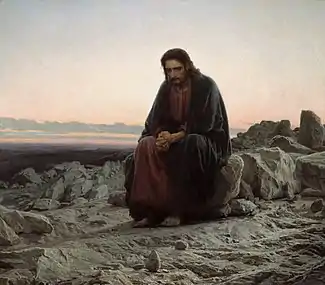Matthew 4:2
Matthew 4:2 is the second verse of the fourth chapter of the Gospel of Matthew in the New Testament. This verse is just preceding the section in Matthew dealing with the temptation of Christ by Satan. Jesus has been led out into the wilderness and in this verse he fasts.
| Matthew 4:2 | |
|---|---|
← 4:1 4:3 → | |
 Ivan Kramskoy's 1872 Christ in the Wilderness | |
| Book | Gospel of Matthew |
| Christian Bible part | New Testament |
Content
In the King James Version of the Bible the text reads:
- And when he had fasted forty
- days and forty nights, he
- was afterward an hungred.
The World English Bible translates the passage as:
- When he had fasted forty
- days and forty nights, he
- was hungry afterward.
For a collection of other versions see BibleHub Matthew 4:2.
Analysis
Hill notes that traditionally fasting presaged a great spiritual struggle, as it does in this verse. The verse alludes to several Old Testament passages.[1] Moses fasts for forty days and forty nights before writing the holy scripture, and Elijah in 1 Kings 19:8 travels for the same period without food. Matthew, unlike Luke, adds "and forty nights" more closely linking the passage to the Old Testament. Another important parallel is with the entire nation of Israel that spent forty years in the desert without much food after the Exodus. A popular theory is that the entire temptation narrative is meant to parallel the history of Israel. Clarke notes that at the time forty was less a specific number and more a general expression for any large figure.[2]
France notes that fasting does not necessarily mean a complete abstinence from food and that Jesus may have been surviving on the sparse food that could be obtained in the desert.[3] Mark does not mention this fasting and Luke implies it but does not use the word. Gundry notes that the author of Matthew seems to be a far more interested in this idea than the other evangelists, and in Matthew 6 again seems to present fasting as a model for good behaviour.[4] This fasting became the model for the practice of Lent in the Roman Catholic and Eastern Orthodox churches, a ritual that lasts forty days, but is today a less than total abstinence. Protestants, in general, do not see this passage as a justification for Lent. Martin Luther felt the ritual was artificial, but useful in focusing the minds of the faithful. John Calvin felt the entire notion was silly and that if imitating Jesus was truly the path to salvation then believers should be striving to walk on water or turn water to wine.
Textual witnesses
Some early manuscripts containing the text of this verse are:
- Papyrus 101 (~ 250)[5][6]
- Codex Vaticanus (325-350)
- Codex Sinaiticus (330-360)
- Codex Bezae (~400)
- Codex Washingtonianus (~400)
- Codex Ephraemi Rescriptus (~450)
References
- Hill, David. The Gospel of Matthew. Grand Rapids: Eerdmans, 1981
- Clarke, Howard W. The Gospel of Matthew and its Readers: A Historical Introduction to the First Gospel. Bloomington: Indiana University Press, 2003.
- France, R.T. The Gospel According to Matthew: an Introduction and Commentary. Leicester: Inter-Varsity, 1985.
- Gundry, Robert H. Matthew a Commentary on his Literary and Theological Art. Grand Rapids: William B. Eerdmans Publishing Company, 1982.
- Thomas, J. David. The Oxyrhynchus Papyri LXIV (London: 1997), pp. 2–4.
- "Liste Handschriften". Münster: Institute for New Testament Textual Research. Retrieved 27 August 2011.
| Preceded by Matthew 4:1 |
Gospel of Matthew Chapter 4 |
Succeeded by Matthew 4:3 |